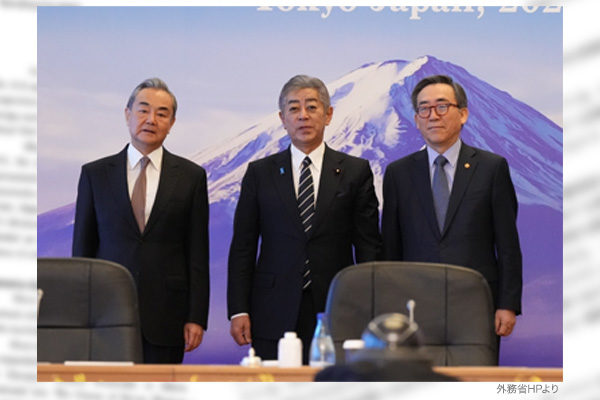U.S. President Donald Trump’s reciprocal tariff policy will come into effect on April 9. The policy represents a crude approach that sets an additional tariff rate based on the ratio of bilateral trade deficits to imports from each trading partner. China’s Xi Jinping government takes advantage of the U.S. policy to behave as if Beijing were a free trade advocate and condemn the United States for violating World Trade Organization rules. China invites Japan’s Shigeru Ishiba government to negotiate a Japan-China-South Korea free trade agreement, setting a trap to divide the Japan-U.S. and U.S.-South Korea alliances.
Xi aiming to divide Japan from America
China under the Communist Party dictatorship has capitalized on and destroyed the free trade system that the U.S. has led since the end of World War II. Trump’s effective additional tariff rate including the reciprocal tariff stands at 47.5% for China, far higher than 20% for Japan and an average 18.8% for all U.S. trading partners. Plagued with a prolonged real estate depression and overproduction of steel, electric vehicles, and other major industrial products, China is accelerating its export dumping offensive. The extremely high tariff on China is a natural choice for the U.S. to counter such offensive.
According to Hong Kong newspapers, Chinese President Xi will visit Vietnam, Malaysia, and Cambodia in mid-April. The U.S. has set the reciprocal tariff at 49% for Cambodia, 46% for Vietnam, and 24% for Malaysia. Chinese companies use the three countries for their indirect exports to the U.S. The Xi government attempts to further expand and enhance China’s influence by winning over Southeast Asian countries shaken by the high U.S. tariffs. China’s overture for the trilateral FTA with Japan and South Korea must be part of a similar strategy.
Impose conditions on resuming FTA negotiations
Japan, China, and South Korea announced the start of negotiations for their FTA in November 2012, but the negotiations have been stalled. This is because China has held fast to typical authoritarian policies including protecting state-run enterprises, forcing foreign companies to transfer technologies to Chinese firms, and monopolizing supply chains for parts and materials. In May 2024 when Trump became likely to retake the U.S. presidency, however, the Japanese, Chinese, and South Korean leaders at their meeting in Seoul agreed to accelerate negotiations to conclude the FTA. In late March when Trump was imposing series of high tariffs, the three countries’ trade ministers at their gathering in Seoul agreed to “keep discussions for speeding up” the FTA negotiations. The Ishiba government, which tends to harbor illusions about a “mutually beneficial relationship based on common strategic interests” with China, may be inclining toward the Xi’s invitation to resume the trilateral FTA negotiations.
The Ishiba government should resolutely impose conditions on the resumption of the FTA negotiations. The conditions should include the elimination of trade barriers and the Xi government’s usual practice of economic coercion. On the strength of China’s monopolistic production of rare earth, rare metals, and other critical minerals that are essential for high-tech products such as semiconductors and EV batteries, the Xi government has restricted their exports, representing its extreme disregard for free trade rules. It is far from any FTA.
Hideo Tamura is a Planning Committee member at the Japan Institute for National Fundamentals and a columnist for the Sankei Shimbun newspaper.


